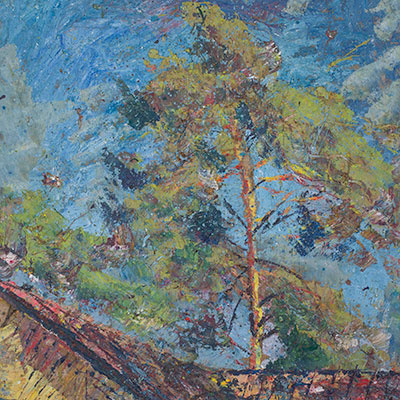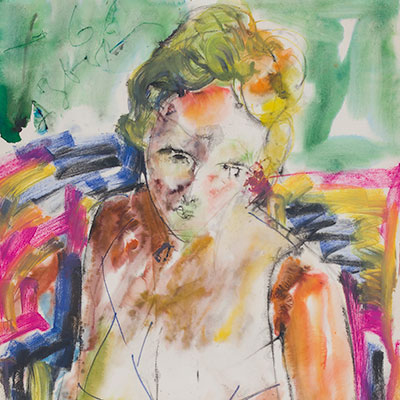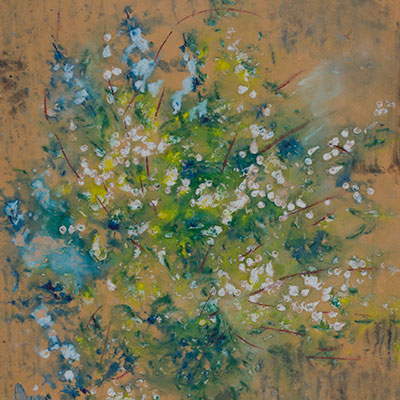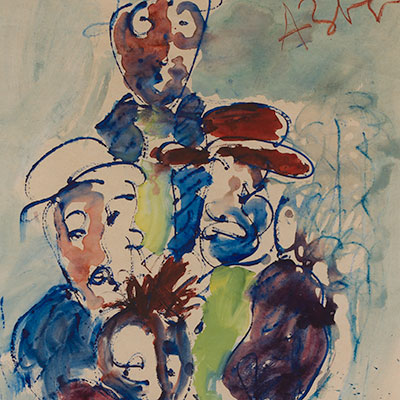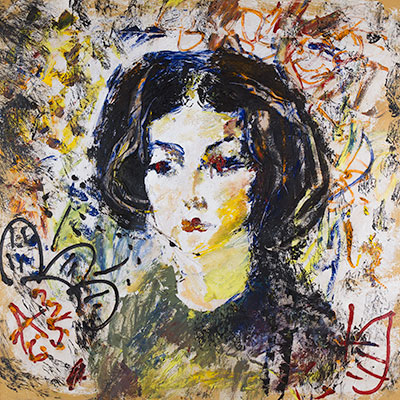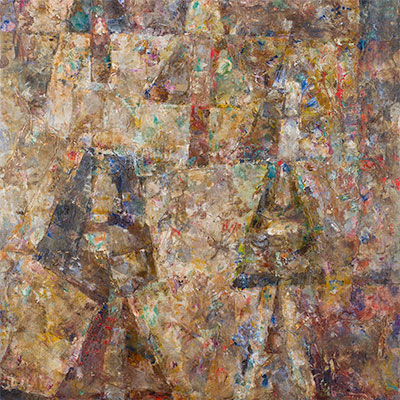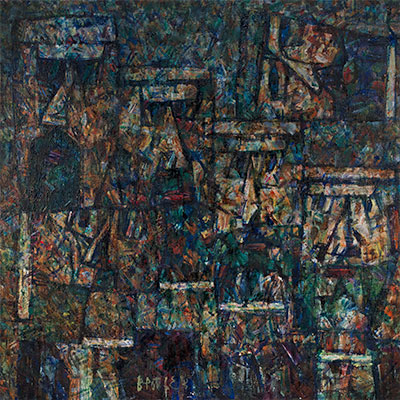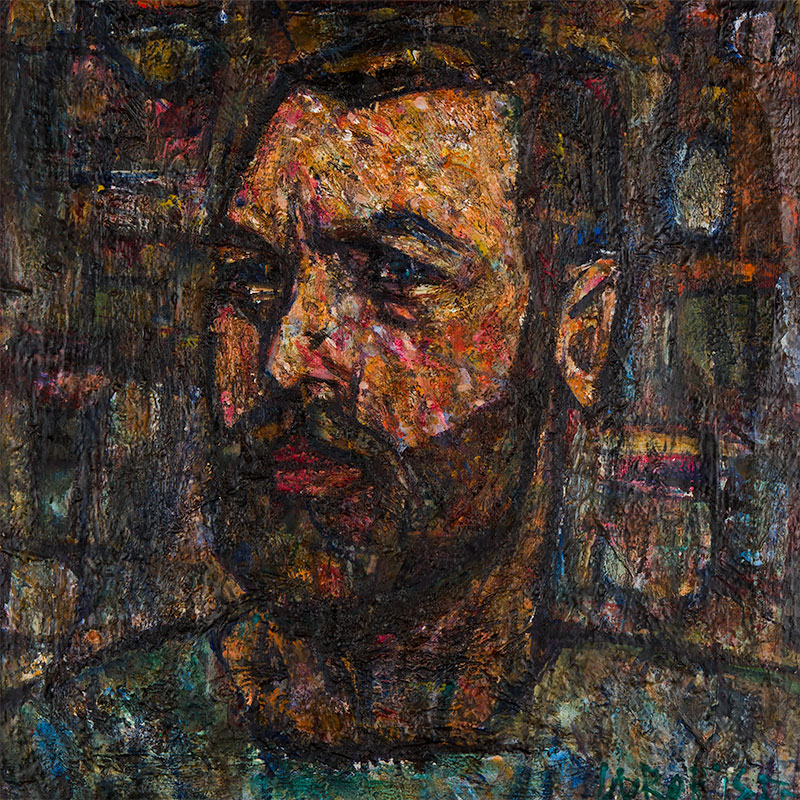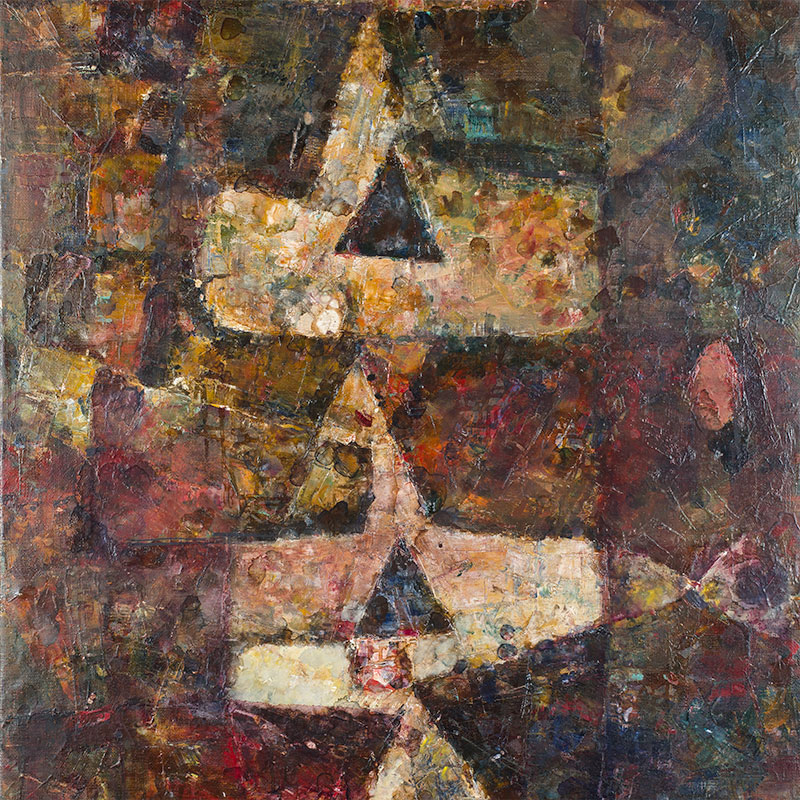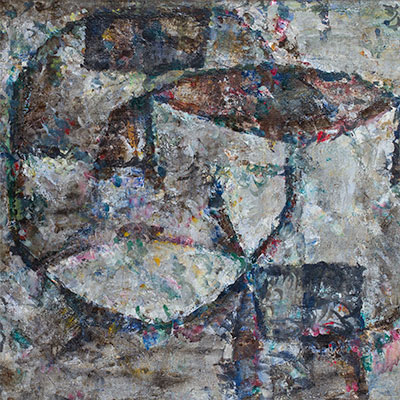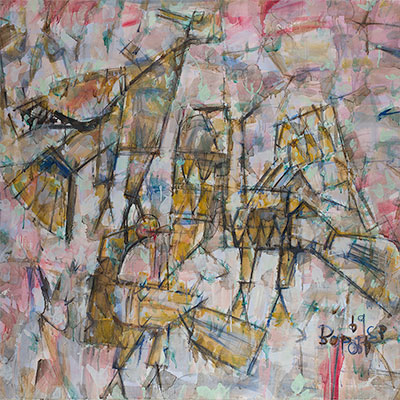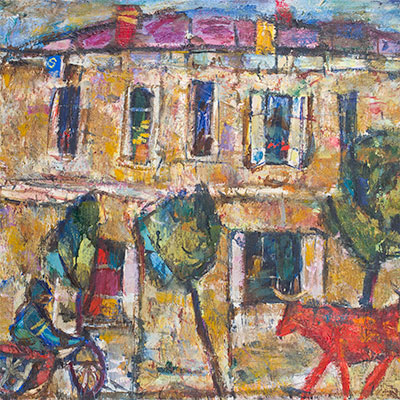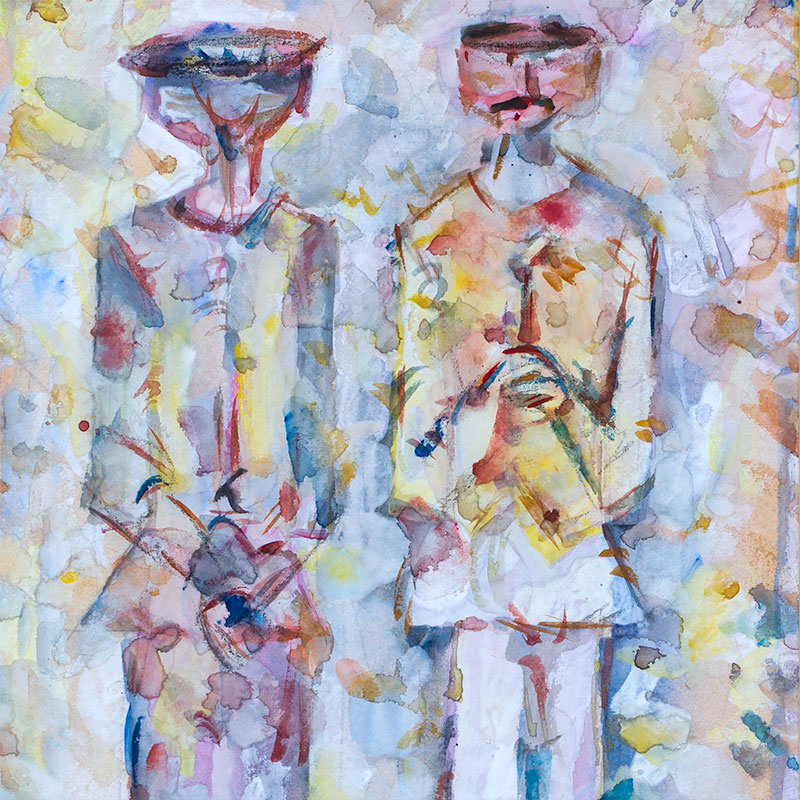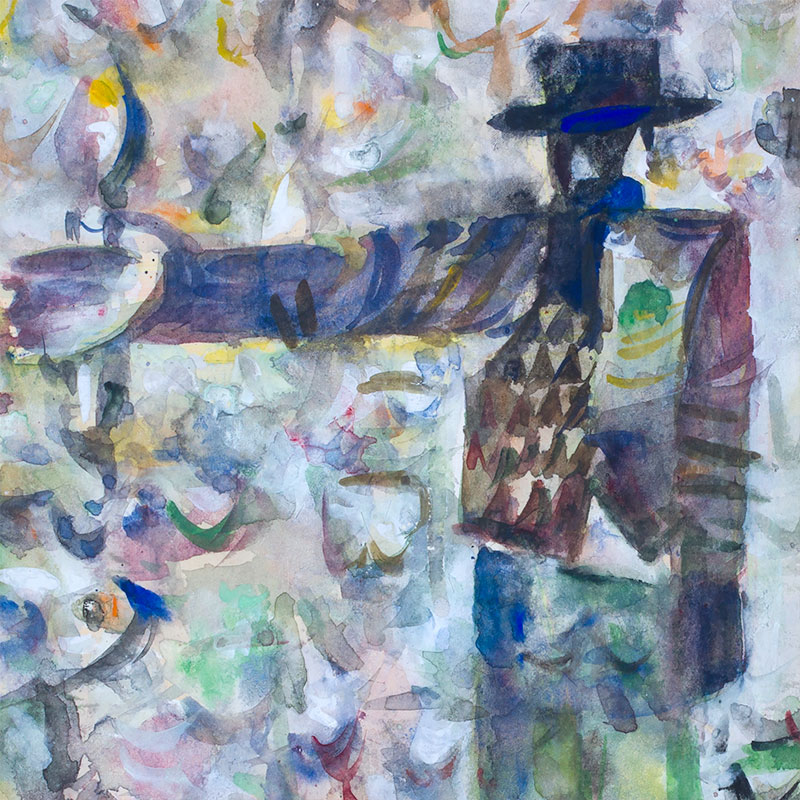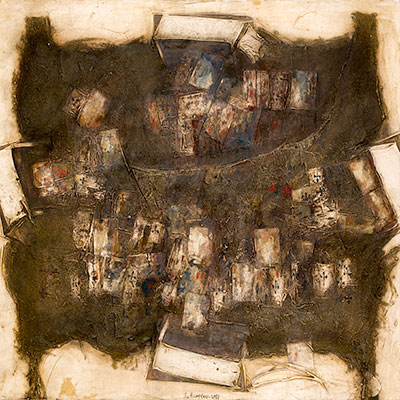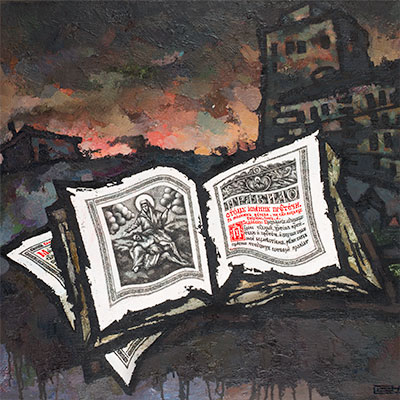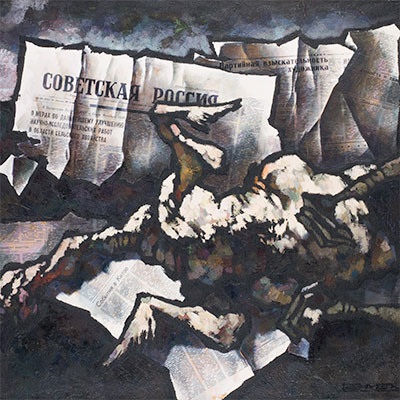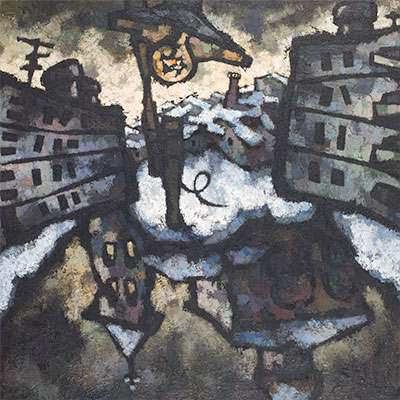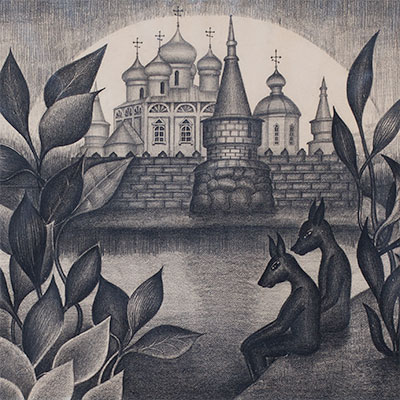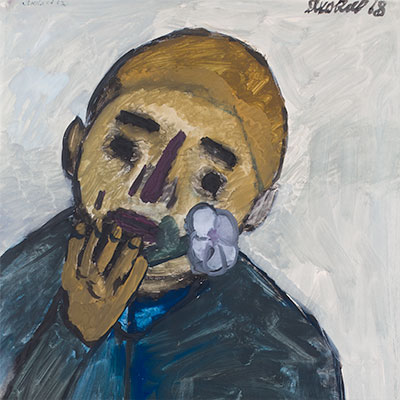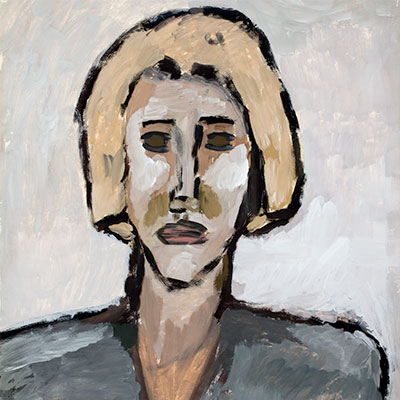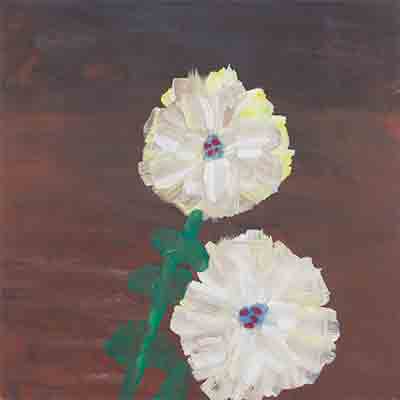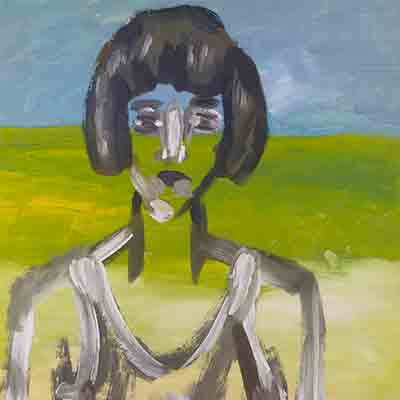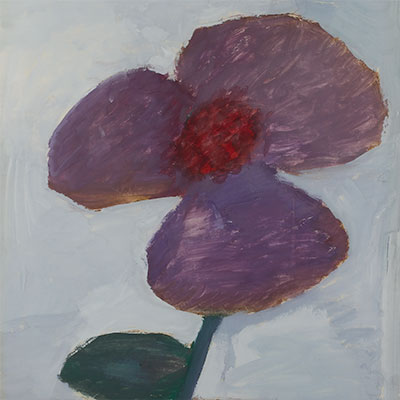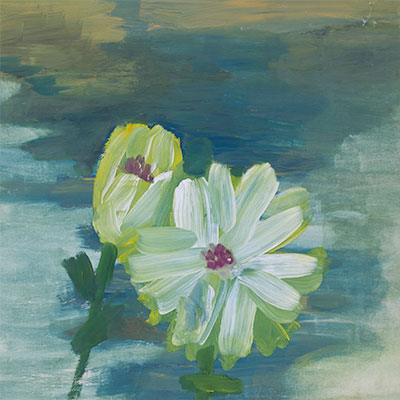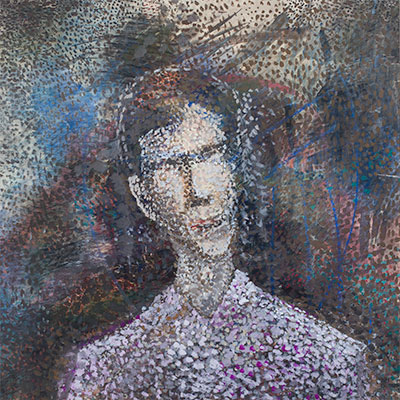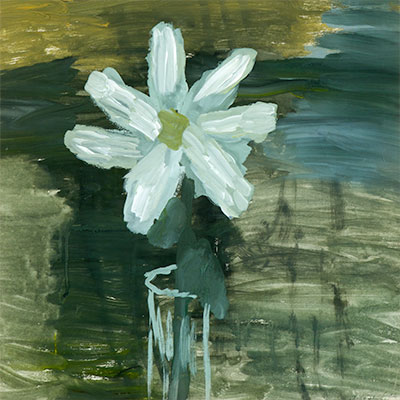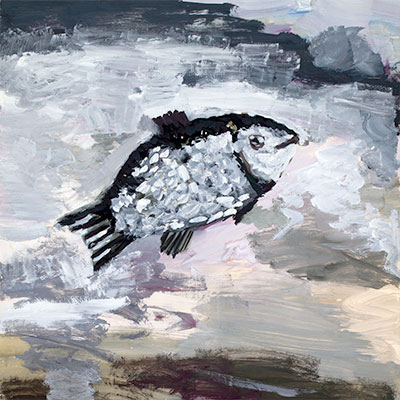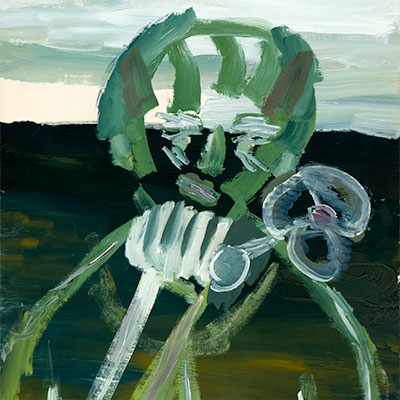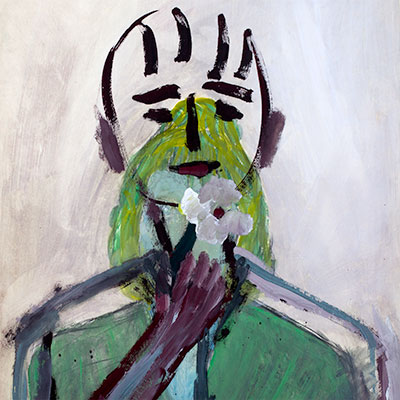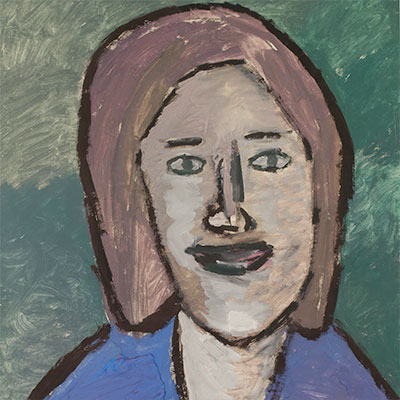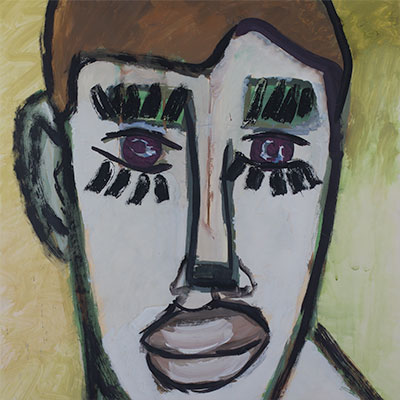
These paintings represent a group of Moscow dissident artists of the 1960's who, collectively and individually, spoke out through their art against Soviet repression of individual liberty and freedom of expression. In this collection of "unofficial" or protest art are religious themes, political criticism, and complaints about the economy, the dismal state of Soviet agriculture and even the poor quality of food available in the marketplace. Other paintings are simply individual artistic expressions of beauty, form, color and theme, the very fact of which defines dissident art as that which does not conform to the requirements of Soviet socialist realism.
These paintings were executed during the regime of Leonid Breshnev, the latter years of which have been described as a period of stagnation and economic decline of the Soviet totalitarian system. The very fact these paintings were produced at all is testimony to the artists' determination not to be silenced by a repressive and tyrannical government. When seeking an understanding of the defeat of the Soviet Union in the Cold War, as well as an insight on present-day Russian society, it is helpful to examine the history of the dissident movement in the Soviet Union as expressed in art and literature.
In stark contrast to the "unofficial" or "underground" art, are several state propaganda posters from the 1960's. Visual comparison of the style of the two groups is revealing.
The principal of socialist realism began with Lenin who said, "Art belongs to the people. It must penetrate with its deepest roots into the very midst of the toiling masses." Stalin formalized the concept into three parts: first, artistic activity must be identified with the proletarian cause; second, art must be based on Marxist-Lenist ideology; third, Soviet art must be an expression of the interests, ideals, and spirit of the working masses. In its early revolutionary education of the toiling masses in the spirit of Socialism, the Communist party defined Socialist realism as "a truthful, historically concrete representation of reality." Obviously, this concept of art leaves little room for the artist to pursue creative freedom of expression.
As a result of the refusal to conform to the rules handed down by the Soviet Communist Party through the Artists Union, the individual dissidents paid a high price; a few with their lives. Generally, though, life was a series of run-ins with the authorities, militia and KGB. There was the occasional arrest and threat of prosecution as a social parasite. It was an uncertain existence, never knowing when one might be arrested or forced to leave Moscow. The artists were prohibited from buying art supplies and materials from the state stores and, consequently, had to procure materials in any way they could. Unofficial artists were not allowed to exhibit in any formal showing in the Soviet Union - museums, institutes, public halls, universities - all of which were controlled by the state.
Nevertheless, the dissident artists and writers were very influential among the intellectual class in Russia and played an important role in the eventual unraveling of the Soviet Union.
These paintings were acquired from the artists in Moscow over a two year period, 1967-1969, during my tenure as a diplomat at the U.S. Embassy there. To choose to be an unofficial artist in the Soviet Union and to engage in active protest against the regime, during a time of stringent totalitarian control of every aspect of public and private life, required considerable personal sacrifice. This exhibit is a tribute to the courage of these artists who refused to allow their individual expressions of life, freedom and thought to be suppressed.
The entire collection was recently appraised with a replacement cost in excess of one-million dollars by the International Society of Appraisers.
Anatoly Timofeivich Zverev, Russian (1931-1986)
Anatoly Zverev was born in Moscow in 1931. He studied at the Institute of the 1905 Revolution but was expelled for his "formalist" tendencies. In the 1960s Zverev was known for his refined artistic taste and extraordinary artistic abilities. In 1965 he exhibited more than a hundred paintings at the Motte Gallery in Geneva, which at the time constituted one of the largest solo shows by an unofficial Soviet artist in the West. Zverev's art is representative of Russian Expressionism; while severely reduced, it remains figurative and recognizable. Zverev's works can be found in many major collections such as Costakis Collection in Greece, Cremona Foundation in Maryland and the Museum of Modern Art in New York. Zverev died in Moscow in 1986. Anatoly Zverev, now considered a national treasure and whom Picasso referred to as Russia's finest living artist.
- Untitled "House and Tree"
1967 Painting
Image: 33.25" Wide x 39" High
Framed: 44.125" Wide x 47.125" High
Medium: Oil, Pine Needles, Leaves, Matches and other material on upstretched canvas stapled to cloth covered board
Description: Expresionist landscape in cool colors with a roofline in the lower foreground and vertical tree under blue sky. - Untitled "Woman Sitting"
1966 Work on Paper
Image: 25.25" Wide x 34.25" High
Framed: 29.125" Wide x 38.125" High
Medium: Gouache on Paper
Description: Half portrait of a seated woman with blonde hair painted with gestural lines and arbitrary color in expressionist style. - Untitled "Flowers"
1965 Work on Paper
Image: 18.75" Wide x 28" High
Framed: 29" Wide x 38" High
Medium: Oil on Paper
Description: Vase with blue and white flowers in loose expressionist style against a neutral background. - Untitled "Clowns"
1965 Work on Paper
Image: 22.375" Wide x 15.5" High
Framed: 21.75" Wide x 28.625" High
Medium: Watercolor on Paper
Description: Three heads with bowler hats rendered in gestural lines and arbitrary colors. - Untitled "Portrait of a Woman"
1965 Work on Paper
Image: 19.125" Wide x 23.125" High
Framed: 22.25" Wide x 26.25" High
Medium: Oil on Paper
Description: Three-quarter portrait of a young woman with black hair and ruby lips with swirling daubs of color in the background in expressionist style.
Valentin llich Vorobiev, Russian (b.1938)
Valentin Vorobiev is one of the leaders of Soviet unofficial art from the 1960s-1970s. In 1961, together with the writers Constantin Paustovsky and Boris Balter, Vorobiev organized the first unofficial art exhibition in Tarusa, where he exhibited the works of several Moscow artists. He was also one of the organizers and a participant in the eponymous Bulldozer and lzmailovo exhibitions. As early as the 1960s, Vorobiev had created his own expressive style, which in France later became known as Figuration libre. Vorobiev is also known as the founder of the French art movement Art-Cloche; as well as this, he initiated 'open studios', which became an annual event from the mid-1980s onwards.
- At Prayer
1967 Painting
Image: 31.375" Wide x 38.875" High
Framed: 32.375" Wide x 39.875" High
Medium: Oil with straw and other material on canvas
Description: Geometric abstraction in earthen tones with daubs of brilliant color featuring praying hand or steeple shaped triangles. - Procession
1968 Painting
Image: 35.25" Wide x 33.625" High
Framed: 36.25" Wide x 34.25" High
Medium: Oil on canvas
Description: Geometric abstraction suggestive of the title in dark muted colors constructed within a loose grid. - Self-Portrait
1969 Painting
Image: 24.375" Wide x24.25" High
Framed: 31.625" Wide x 31.125" High
Medium: Oil on canvas
Description: Portrait of the bearded artist in dark colors with a muted geometric background. - Triangles
1968 Painting
Image: 27.5" Wide x 39.25" High
Framed: 28.5" Wide x 40.25" High
Medium: Oil on canvas
Description: Geometric abstraction in a variety of colors with two, dominate dark triangles surrounded by lighter earth tones. - Untitled "Heads"
1968 Painting
Image: 31" Wide x 23.375" High
Framed: 35.25" Wide x 27.625" High
Medium: Oil on canvas
Description: Geometric abstraction in cool muted colors with two interlocking shapes that suggest heads. - Birds
1969 Painting
Image: 39" Wide x 37.125" High
Framed: 40" Wide x 38.25" High
Medium: Oil on canvas
Description: Geometric and biomorphic abstraction with dominate black lines suggesting birds on a mosaic-like painterly background - Tarusa
1967 Painting
Image: 39" Wide x 23.5" High
Framed: 40" Wide x 24.5" High
Medium: Oil on canvas
Description: Stylized depiction of a two-story building with windows on a street with trees, flanked by a cyclist on the left and two cows (one red, one yellow) and a lady at the right. - Untitled "Man Going and Coming"
1967 Work on Paper
Image: 8" Wide x 9.375" High
Framed: 12.75" Wide x 16.125" High
Medium: Watercolor on paper
Description: Two vertical people of rectangular form depicted coming and going in a loose patchwork mosaic of light color. - Untitled "Man Holding Tool"
1967 Work on Paper
Image: 8.25" Wide x 11.625" High
Framed: 12.75" Wide x 16.125" High
Watercolor on paper
Description: A man with an outstretched hand holding a paint brush in a loose patchwork mosaic of light colors.
Vladimir Nikolaevich Nembukhin, Russian (1925-1999)
Vladimir Nemukhin is one of the founders of the Lianozov group. In 1974 he was involved in the 'Bulldozer Exhibition' and acted as go-between in negotiations with the authorities and he joined the Lianozov group. Nemukhin carries on the tradition of the Russian avant-garde. He calls the basis of his abstract compositions 'Russian cubo-futurism'. His compositions include collages, which often contain playing cards. He frequently painted using mixed media, a painting-graphic technique as it were, as well as on paper (the Jack of Diamonds series from the end of the 1960's through to the start of the 1970's). The assimilation of the picture with the subject brought his work close to the decade of the 1980's with its pop-art. During this period he often turned to three-dimensional sculptural abstractions, biomorphic or geometrical (the 'compositions-dedications' series) and then, as he increasingly began exhibiting his own work, the painting and graphic plates were accompanied by large illustrations. In recent years, in addition to his series of paintings and graphical works, the artist has begun to create sculptures. He also works with ceramic ware, paying homage to the traditions dating back to the time of Malevich, Chashnik and others. His suprematic compositions on plates also burn with red and black. A book entitled 'Nemukhin monologues' was published in 1999 containing the artist's reflections as recorded by M. Uralski. From the end of the 1960's onwards, his paintings have also gained increasing recognition in the West, although at that time the artist was living in Moscow and Priluki. At the turn of the millennium, he was spending most of his time in Dusseldorf, Germany, continually travelling back to Russia.
- Untitled "Card Table"
1968 Painting
Image: 42.55" Wide x 37.75" High
Framed: 43.5" Wide x 38.75" High
Medium: Oil on canvas with collage
Description: Abstract depiction of a card table with real playing cards collaged to the surface as seen from directly above with four chair backs painted in earthen tones.
Oskar Yakovlevich Rabin, Russian (b.1928)
Oskar Rabin's work, celebrated in the West as 'Solzhenitsyn in painting', honestly and eloquently reflected the mood in society during the 1960's and 1970's. An outstanding master with a deeply individual way of seeing the world, Oskar Rabin was one of the originators of non-conformism and one of the organizers of the 'Lianozovo Group' which grew up around Evgeny Kropivnitski. Over a period of seven years {1958-1965), the former camp barracks in Lianozovo, where Oskar Rabin lived with his wife, Valentina Kropivnitskaya, acted as the center of the progressive intelligentsia. Surrounded by his family, life in a Moscow suburb with 'ignoble' objects from everyday Soviet material life and its dramatic absurdity was for many years the central theme of Rabin's creativity. The artist's favorite genres included landscape, still-life and interiors, continuing in the tradition of 1920's European expressionism. Trying to imbue his painting with a social-critical tone and bring out the 'anti-humanity' of modern man's environment, Rabin uses a distortion of perspective, the principals of deformation and the destruction of large-scale relationships. Through his emotionally saturated style, as well as his laconic manner, Rabin interweaves different genres and artistic devices, elements of collage and assemblage are introduced into the paintings. The drama of the works is highlighted by chronological 'markers', denoted by fragments of newspapers, stickers and labels. The uncorrupted truth of life, seen by the communist authorities as dissidence, released from the chains social-realism, was cause for Oskar Rabin to lose his Soviet citizenship. Moving to Paris in 1978, he gained there new inspiration and international recognition.
- Bible
1969 Painting
Image: 35.375" Wide x 27.625" High
Framed: 36.375" Wide x 28.625" High
Medium: Oil on canvas
Description: An open Russian bible with red lettering and a picture of Christ rests on the ground in a dark urban environment as a social critique. The pictorial images are outlined in black. - Chicken Wrapped in Sovietskaya Rossia
1968 Painting
Image: 42.875" Wide x 31.75" High
Framed: 43.875" Wide x 32.75" High
Medium: Oil on canvas with collage
Description: A chicken, surrounded by sections of a Russian newspaper, portrayed on the ground in a dark environment as a social critique. The pictorial images are outlined in black. - Reflections of Church
1967 Painting
Image: 39.375" Wide x 31.375" High
Framed: 40.375" Wide x 32.5" High
Medium: Oil on canvas
Description: Moscow street scene in the snow with a street lamp and a reflection of a Russian Orthodox Church on the snow covered street, outlined in black.
Valentina Kroninmuchkaya, Russian
– NO BIOGRAPHICAL INFORMATION AVAILABLE –- Untitled "Monastery on Lake"
1968 Work on Paper
Image: 23.5" Wide x 18.75" High
Framed: 30.25" Wide x 24.5" High
Medium: Pencil on paper
Description: Black and white drawing depicting two hybrid creatures sitting on the bank of a lake with two linear stalks of leaved foliage and a multi-domed monastery in the background.
Vladimir lgorevich Yakovlev, Russian (1934-1998)
Vladimir Yakovlev was born into an artistic family - his grandfather M. Yakovlev was an artist too. He didn't get a professional art education, but in the sos he worked as retoucher in "The lskusstvo" {Art) publishing house in Moscow and later attended the lessons of the famous Non-artist V.Ya. Sitnikov. His contact with artists belonging to the "Other Art" group formed his artistic principles. The international exhibitions that were organized within the framework of the 1957 International Youth Festival provided a decisive impulse for him to concentrate on painting. In the late SOs Yakovlev tried his hand at Abstract art but his style proved to be at its best in small Figurative compositions painted mainly in gouache. His subjects are simple: flowers and people, sometimes animals and landscapes. However, what impresses most of all is the emotions expressed by the color pattern and sharp contrasts making it possible to convey lyric and dramatic elements in one image. Yakovlev's "primitive" art did not mean that he was not skilled in academic painting. Rather it reflects his wish to expose the spiritual pivot of an object and turn it into a sign. The artist's mental ill health reinforced his artistic vision. It was as if Yakovlev was physically incompatible with the oppressive Soviet regime. From 1945 onwards he spent long periods in mental clinics and after his mother's death in 1983 moved into a neurological boarding house. Also he was rapidly losing his eyesight, which was partly restored in the 90s. Paradoxically, he created his best works when he was almost blind. Yakovlev's work was a unique example of genuine art stemming from outsider status.
- Untitled "Young Boy"
1968 Work on Paper
Image: 24" Wide x 33.5" High
Framed: 28" Wide x 37.75" High
Gouache on paper
Description: Child-like portrait of a young man holding a flower to his face with his left hand painted in large brush strokes, big patches of color and thick black lines. - University Student
1969 Work on Paper
Image: 24" Wide x 33.875" High
Framed: 27.25" Wide x 37.25" High
Gouache on paper
Description: Child-like portrait (chest and shoulders) of a woman painted in cool colors with large brushstrokes, patches of color and thick black lines. - Untitled "Flowers"
1969 Work on Paper
Image: 25.625" Wide x 33" High
Framed: 31" Wide x 40.5" High
Gouache on paper
Description: Two white flowers with green stem on a painterly earthen tone background under a sliver of light colored sky in child-like fashion. - Untitled "Transparent Woman"
1969 Work on Paper
Image: 23.625" Wide x 33" High
Framed: 31" Wide x 40.5" High
Gouache on paper
Description: Child-like half-portrait of a woman in a sheer white blouse with vertical bands of background colors showing through her outline. - Untitled "Purple Flower"
1969 Work on Paper
Image: 31" Wide x 40.5" High
Framed: 23.625" Wide x 33" High
Gouache on paper
Description: A large purple flower with red ovary and a single leaf stem on a two-tone background suggesting earth and sky in a child-like style. - Untitled "Flowers"
1969 Work on Paper
Image: 31" Wide x 40.5" High
Framed: 23.5" Wide x 33.125" High
Gouache on paper
Description: Two yellowish and white flowers with green stems in a lower, center foreground on a painterly background of predominately blue-green colors and white. - Father as Young Man
1968-69 Work on Paper
Image: 24" Wide x 24" High
Framed: 30.25" Wide x 30.25" High
Gouache on paper
Description: Pointillist style portrait of a young man of slender face and brown hair build with daubs of color and white paint. - Untitled "White Flowers in a Glass"
1969 Work on Paper
Image: 23" Wide x 33.125" High
Framed: 37.25" Wide x 27.25" High
Gouache on paper
Description: A large white flower in a clear glass at center foreground on a painterly background of cool and earthen colors suggesting a landscape. - Untitled "Fish"
1969 Work on Paper
Image: 24" Wide x 34" High
Framed: 27.5" Wide x 37.5" High
Gouache on paper
Description: A black outlined fish with white scales floats in the center ground of a painterly background of cool colors suggesting water. - Untitled "Transparent Woman"
1969 Work on Paper
Image: 34" Wide x 33.75" High
Framed: 37.25" Wide x 27.25" High
Gouache on paper
Description: Bold lines of light colors and white paint loosly define a figure holding a flower without solid form as if transparent. - Untitled "Transparent Boy"
1969 Work on Paper
Image: 24" Wide x 33.5" High
Framed: 27.75" Wide x 37.5" High
Gouache on paper
Description: Portrait of a boy holding a flower to his chin depicted with arbitrary color and simple black lines to articulate the face. - Daughter of the Minister of Transportation
1969 Work on Paper
Image: 25.625" Wide x 33" High
Framed: 31" Wide x 40.5" High
Gouache on paper
Description: Child-like head and shoulder portrait of a female in lavender sweater with brown hair outlined in black on green background. - Boris Pasternak
1969 Work on Paper
Image: 34" Wide x 33.75" High
Framed: 29" Wide x 38.625" High
Gouache on paper
Description: Child-like male portrait head and neck with accentuated eyelashes painted with harsh black lines.
